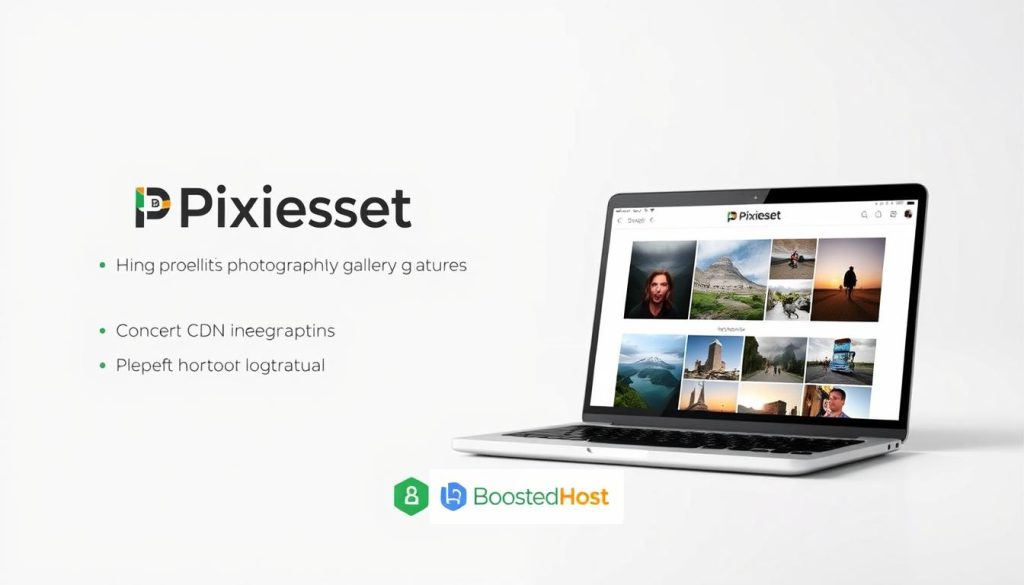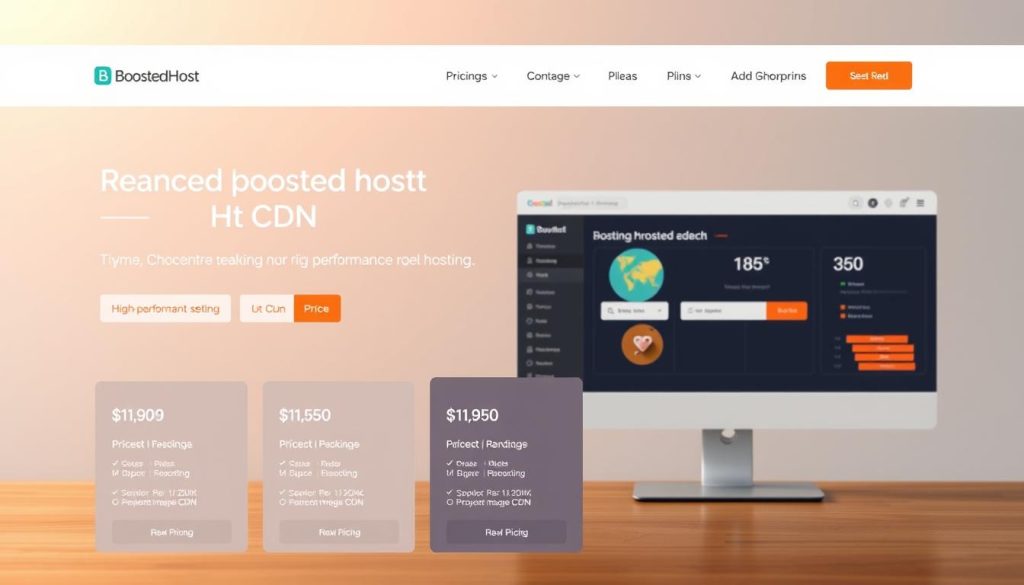Surprising fact: over 70% of photo site visitors abandon pages that take more than three seconds to load, so your images and delivery matter more than ever.
You need a site that keeps color true and pages fast. In 2025, choices span traditional web hosts like SiteGround, A2 Hosting, Hostinger, Bluehost, and InMotion to builder-first platforms such as Squarespace, Wix, Format, Pixpa, and Pixieset.
Some services add free CDNs, NVMe or SSD storage, and automated backups so galleries stay responsive worldwide. Others focus on client tools—SmugMug, 500px, and Pixieset offer galleries, storefronts, watermarks, and SEO features that simplify selling and proofing.
We’ll cut through the marketing claims and show which plans give you SSL, uptime, unmetered traffic, and true-to-life compression. That way you can pick a website route that matches your workflow, budget, and how you sell images online.
Key Takeaways
- Fast delivery matters: CDNs and NVMe/SSD storage speed up gallery load times.
- Pick a platform that balances color accuracy with compression to protect image quality.
- Look for built-in tools like SSL, backups, and client galleries to reduce maintenance.
- Builder platforms offer ease; traditional web setups offer more control and plugins.
- Check real plan details—domains, unmetered traffic, and add-on RAW policies—before you commit.
Why your photography website needs specialized hosting in 2025
A photography website in 2025 must serve large images quickly and accurately across the globe. Slow pages lose clients, so your hosting choice should include a global CDN and fast storage like NVMe or SSD.
Security and uptime matter. Free SSL and strong SLAs keep buyers confident, while features like watermarking and ecommerce help you monetize without extra plugins. Pick a service that reduces maintenance so you can shoot more and manage less.
- Fast delivery: CDN edge caching makes galleries feel instant from NY to London.
- Performance stack: LiteSpeed caching and SSD/NVMe speed up image-heavy pages.
- Client tools: Built-in galleries, privacy controls, and carts save time.
- Image fidelity: Choose platforms that preserve high-res output and let you control compression.
- Scale & trust: Unmetered bandwidth and auto-updates help your site handle spikes and protect your business.
You’ll need a hosting partner that understands web photography workflows and the specific tools photographers rely on. That alignment keeps your site fast, secure, and ready to sell.
Quick picks: Top platforms by use case
Start by deciding if you want WordPress control, a gallery-first service, or a drag-and-drop builder. Each route suits different workflows, so match the option to how you shoot, proof, and sell.
Fast traditional WordPress hosts
SiteGround pairs shared WordPress hosting with a free CDN and unmetered traffic. A2 Hosting supports gallery apps like Piwigo and Zenphoto and uses SSDs for speed. Hostinger adds LiteSpeed caching, free SSL, automated backups, and a free CDN on Business plans.
Turnkey gallery and selling platforms
SmugMug gives unlimited full-res JPEG storage, watermarks, and a storefront. 500px brings community reach, licensing, and analytics. Pixieset offers free hosting, no bandwidth caps, automatic SSL, and a global CDN.
All-in-one website builders with strong galleries
Wix provides 900+ templates, media tools, bookings, and built-in analytics. Squarespace focuses on business features and ecommerce with a polished site builder.
| Use case | Top picks | Key upside |
|---|---|---|
| WordPress speed & control | SiteGround, A2 Hosting, Hostinger | CDN, caching, SSD/NVMe storage |
| Gallery-first selling | SmugMug, 500px, Pixieset | Watermarks, storefronts, no bandwidth caps |
| Drag-and-drop design | Wix, Squarespace | Templates, ecommerce, bookings |
Tip: compare pricing and plans against the storage, CDN, and ecommerce features you actually use. That keeps your site fast and avoids paying for unused extras.
The buying checklist for photographers: speed, storage, bandwidth, and galleries
Picking a plan starts with a short checklist: speed, storage, bandwidth, privacy, and commerce tools. Use this to compare real features, not just marketing claims.
Bandwidth and CDN
Prioritize a CDN and uncapped bandwidth so gallery pages load fast when dozens of large images hit a single page. SiteGround and Hostinger include CDNs on some plans, and Pixieset delivers via a global CDN with no bandwidth caps.
Disk space for libraries and backups
Calculate your storage needs from RAW and JPEG archives plus backups. Look for SSD or NVMe tiers (A2 and Hostinger offer fast storage) so your dashboard and media manager stay snappy.
Client galleries, privacy, and ecommerce
Verify passworded galleries, watermarking, and private proofing tools before you commit. If you sell prints, confirm checkout, tax, shipping, and coupon options—SmugMug and Pixieset include many of these features.
Security, SSL, WAF, and uptime
Insist on free SSL and baseline WAF/malware scanning. Hosts like Bluehost, Hostinger, and Wix include SSL; uptime near 99.9% is common. Automated backups and one‑click restores protect your site from bad updates.
- Pick a plan where CDN, storage, and ecommerce features match how you work.
- Confirm RAW vs JPEG policies and compression controls for faithful color and detail.
- Check uptime SLAs and backup tools so you don’t lose bookings or work.
Traditional web hosting for WordPress: performance and control
If you run WordPress for image-heavy pages, pick a host tuned for media delivery and plugin freedom. A traditional web stack gives you control over caching, backups, and migrations so your website scales as your library grows.
SiteGround: CDN included, strong speed, unmetered traffic
SiteGround bundles a free CDN, unmetered traffic, and solid uptime (99.9%). Entry pricing starts near $2.99/mo, making it easy to get a fast website without extra add‑ons.
A2 Hosting: gallery software support and SSD speed
A2 Hosting supports dedicated gallery apps like Piwigo and Zenphoto and offers SSD tiers. That makes it a good pick if you want to run custom galleries and keep storage responsive.
Hostinger: LiteSpeed caching, free CDN (Business), NVMe storage
Hostinger adds LiteSpeed caching, automated backups, free SSL, and a free CDN on Business tiers. NVMe storage appears on higher plans, which helps with large media libraries and faster page loads.
Quick notes on other providers
- Bluehost — beginner-friendly builder, free domain/SSL, high uptime.
- HostGator — affordable WordPress plans and broad plugin support.
- InMotion — roomy entry tier (100GB SSD, unmetered bandwidth) and upgrade paths.
- HostPapa & GoDaddy — managed options, generous storage, and simple builders for quick launches.
| Provider | Key features | Good if you need |
|---|---|---|
| SiteGround | Free CDN, unmetered traffic, 99.9% uptime | Fast delivery across regions |
| A2 Hosting | SSD storage, supports Piwigo/Zenphoto, VPS/Dedicated options | Custom galleries and high I/O |
| Hostinger | LiteSpeed, free CDN on Business, NVMe on higher tiers | Cost-effective caching and storage |
Tip: match plan tiers to library size and expected traffic so you don’t underbuy or overpay. If you want a concise comparison of fast WordPress options, see this fast WordPress hosting guide to compare features and pricing quickly.
Professional photography platforms: built for portfolios, proofing, and sales
Professional platforms focus on client workflows, sales tools, and gallery controls that make running a photo business easier. They package private galleries, watermarking, and checkout so you can deliver proofs and sell prints without plugin drama.
SmugMug offers unlimited full‑resolution JPEG storage, private galleries, custom display sizes, and watermarks. Its integrated cart, price lists, coupons, and Lightroom integration make it simple to publish and sell photos. Plans with storefront tools start around $21.50/mo annually.
500px gives you reach: a community of ~16M photographers, portfolio-style profiles, advanced analytics, and a licensing marketplace. Pricing starts near $2.99/mo with a free 30-day trial to test exposure and stats before upgrading.
- Choose SmugMug if unlimited storage, client galleries, and built-in checkout matter most.
- Choose 500px if you want community exposure, licensing options, and analytics to boost visibility.
| Platform | Key tools | Good if you need |
|---|---|---|
| SmugMug | Unlimited JPEG storage, private galleries, watermarks, integrated cart | Direct sales, client proofing, Lightroom workflow |
| 500px | Community profiles, licensing, advanced stats, Editor exposure | Audience reach and licensing revenue |
| Both | Private galleries, pricing tiers, trials or plans to test | Protect work while selling with low friction |
All‑in‑one solutions for photographers: Format and Pixpa
If you want a no-code route, all‑in‑one platforms put design, selling, and security under one roof. These services bundle the core website tools you need to run a small studio without juggling plugins or servers.
Format focuses on polished templates and client workflows. It offers 90+ templates, client contracts, password‑protected galleries, domain registration, SEO tools, and social integrations. Plans start near $8/mo (annual Basic) with higher tiers for more images and features.
Pixpa: visual editor, client galleries, branded checkout
Pixpa brings 150+ responsive templates and a drag‑and‑drop visual editor. Client galleries support viewing, downloads, and purchases. Branded checkout and automated order fulfillment reduce manual work. Pixpa includes free SSL, domain connection, 24/7 chat, and plans from $3.60/mo on a two‑year Basic with a 15‑day free trial.
- You’ll choose Format if you want curated templates, contract tools, and easy domain setup.
- You’ll pick Pixpa for more templates, a visual editor, and streamlined sales automation.
- Compare pricing and plan features against storage needs and client tools before you commit.
- Focus on client experience: clear gallery navigation, fast mobile pages, and simple checkout.
All‑in‑one website platforms: Wix and Squarespace for photography sites
If you want to launch a refined site fast, Wix and Squarespace wrap design, commerce, and scheduling into one platform. Both remove server setup and give you templates, SSL, and domain tools so you can focus on shoots and clients.
Wix: templates, media tools, and built‑in bookings
Wix ships with 900+ templates, media galleries, image quality controls, and scheduling software. It includes built‑in analytics, a custom domain, SSL, and 99.99% uptime.
Pricing starts around $17/mo with 2GB storage on entry plans; higher plans add more storage and commerce features. Use Wix if you want a huge template library and baked‑in bookings without a steep learning curve.
Squarespace: commerce and clean portfolio layouts
Squarespace focuses on business tools, marketplace integrations, and polished portfolio templates. Plans run $16–$49/mo and higher tiers add commerce APIs and unlimited bandwidth for stores.
Both builders are simple to use, but note vendor lock‑in: you can’t export a site to another host without rebuilding. Check pricing and plan storage before you commit, and favor mobile‑optimized templates so your galleries stay crisp on phones.
Pixieset spotlight: free hosting, global CDN, and zero‑maintenance security
Pixieset makes launching a clean photography website fast by bundling hosting, global delivery, and security into one easy service.

Bandwidth with no caps, automatic SSL, and enterprise‑grade uptime
You’ll host your site with no bandwidth caps, which is useful when you publish large galleries or see traffic spikes.
Automatic SSL and continuous uptime monitoring mean you don’t manage patches or certificates. The platform handles security and keeps access stable at enterprise standards.
SEO tools, blogging, and photographer‑first content blocks
Pixieset includes photographer‑first blocks, a drag‑and‑drop builder, and flexible page sections so your pages look cohesive without code.
Simple SEO guidance, built‑in blogging, and basic analytics help your work surface more often in search and reach clients across the web.
- Free hosting with uncapped bandwidth.
- Global CDN for faster delivery worldwide.
- Zero‑maintenance security and automatic SSL.
Image CDNs and caching: how they keep your galleries fast
CDNs and smart caching are the engine behind fast image galleries and low latency worldwide. They move heavy files off your origin server so visitors load photos from a nearby edge server.
Global delivery and latency benefits
When your website uses a CDN, U.S. and international clients fetch images from an edge node near them. That cuts round trips and improves perceived speed.
Result: faster page loads, better Core Web Vitals, and a smoother client experience across regions.
Built‑in vs add‑on CDNs
Some platforms include a CDN out of the box. SiteGround offers a free CDN on shared plans. Hostinger adds a free CDN on Business tiers. UK2 includes Cloudflare on select WordPress plans. Pixieset delivers all sites via a global CDN with no bandwidth caps.
Tip: combine CDN delivery with server caching (LiteSpeed) and SSD/NVMe storage to lower payloads and server response times.
| Provider | CDN included | Caching / Storage |
|---|---|---|
| SiteGround | Free CDN on shared plans | Server caching, SSD tiers |
| Hostinger | Free CDN on Business | LiteSpeed caching, NVMe on higher plans |
| UK2 | Cloudflare on some WP plans | Standard caching, SSD |
| Pixieset | Global CDN, uncapped bandwidth | Platform-managed caching |
Gallery experience matters: client proofing, privacy, and selling prints
A smooth gallery flow helps clients go from viewing to buying in minutes. Your site should combine private review spaces with clear checkout so you spend less time chasing approvals and orders.
Locking down client work means passworded galleries, time-limited access, and simple favorite tools so clients approve shots fast. SmugMug supports private galleries, watermarks, coupons, and price lists on Pro plans.
Private access, protection, and pricing
You’ll protect images with watermarks and control display sizes to discourage scraping. Use coupons and pricing lists to make quotes clear and speed purchases.
Checkout, carts, and fulfillment
Integrated carts and checkout keep buyers on your site instead of sending them to third-party stores. Pixpa automates order fulfillment so print orders move to production without manual steps.
- Keep mobile navigation intuitive: fast lightboxes and next/previous actions.
- Prioritize platforms that handle taxes, shipping, and receipts.
- Use built-in tools that balance privacy with easy client access.
“Great galleries turn approvals into income without extra work.”
Color accuracy and file handling: keeping your photos true to life
True color and crisp detail start with how you export and serve files to viewers. Your choices before upload matter more than platform marketing. A CDN and SSL speed delivery but do not change color; compression and display sizes do.
Display sizes, compression, and preserving high‑resolution detail
Control display sizes so the site sends the right image weight to each device. Resize hero images less aggressively and let the platform avoid extra compression when possible.
- Keep vibrant tone: export sRGB for web and test on common screens to catch shifts.
- Override defaults: confirm whether a platform auto-compresses and how to disable it for select images.
- Balance: create an export preset that protects micro‑contrast while trimming bytes.
JPEG vs RAW policies and practical workflows
Serve optimized JPEGs from your master exports and keep RAWs offline or in cloud archives. SmugMug, for example, offers unlimited full‑resolution JPEG storage with optional RAW archiving as an add‑on, so you can match storage to workflow.
- Test web content with sRGB exports before publishing.
- Plan storage and space per plan to avoid surprise limits when you add client galleries.
- Use Lightroom or Capture One presets to automate consistent exports and save time.
“Preserve your look by controlling exports, then let delivery tools handle fast, reliable access.”
Pricing and plans: getting enough storage and speed without overpaying
Picking the right plan means matching your current photo library and expected traffic, not guessing. Map how many high‑res files you host and how often clients download them. That simple count drives sensible pricing choices.

Entry, mid, and high‑end tiers differ mainly in storage, CPU, and included delivery tools like CDNs and backups.
Entry‑level vs mid‑range vs high‑end tiers
Entry plans often start near $2.69–$3.41/mo and cover small sites with limited galleries. Examples: SiteGround and A2 list shared plans near $2.99/mo; Hostinger’s shared tiers run similar prices.
Mid‑range plans add NVMe or larger SSD pools, free CDN, and automated backups. Hostinger Business and many builder plans sit here.
High‑end tiers — VPS or dedicated — climb to $259.99/mo (SiteGround dedicated) and suit studios that need sustained throughput and large libraries.
What “unmetered” and “unlimited” really mean
Unmetered traffic usually means no fixed cap but a fair‑use policy. Providers reserve the right to throttle extreme use.
Unlimited storage claims vary. Some services truly avoid bandwidth caps (Pixieset notes no limits), while others cap account actions or require add‑ons for RAW archives.
- Map needs: match storage and speed to your current library before you upgrade.
- Compare price inclusions: CDN, SSL, backups, and ecommerce can save money versus add‑ons.
- Watch renewals: intro pricing can jump after the first year — factor total yearly cost into decisions.
- Check support and uptime: a cheap plan that fails during peak season costs more than a slightly higher monthly service.
| Tier | Typical price (mo) | What it adds |
|---|---|---|
| Entry | $2.69–$3.41 | Basic plan, small storage, limited CDN |
| Mid | $8–$30 | NVMe/SSD, free CDN, backups, ecommerce |
| High | $50–$259.99 | VPS/dedicated, large I/O, SLA, priority support |
“Map your library and traffic first — then pick the plan that fits those numbers, not the shiny extras.”
Website builders vs WordPress: which path fits your photography business
Deciding between a visual builder and WordPress shapes daily workflow and long‑term options. Pick the path that matches how often you redesign, which integrations you need, and how much control you want over data.
Templates, SEO, and no‑code design versus plugin flexibility
Website builders like Wix and Squarespace give you drag‑and‑drop templates, built‑in SEO prompts, analytics, and commerce without plugins. You launch fast and edit pages by eye.
WordPress on hosts such as SiteGround, A2 Hosting, or Hostinger gives plugin freedom, custom themes, and full control over site performance stacks (CDN, caching, NVMe). That flexibility helps when you need bespoke tools or advanced SEO structured data.
Migration trade‑offs with proprietary platforms
Note that many builders lock content into their platform. Migration is possible but often requires rebuilding pages and exporting data manually. If long‑term portability matters, WordPress keeps your data and themes portable between sites and providers.
| Approach | Key upside | Trade‑offs |
|---|---|---|
| Wix / Squarespace | Polished templates, integrated tools, quick launch | Limited portability, vendor lock‑in |
| WordPress (SiteGround, A2, Hostinger) | Plugin flexibility, data control, CDN options | Requires maintenance and occasional setup |
| Hybrid | Use builders for landing pages + WP blog | More admin but balanced features |
“Choose based on how you work, not just on looks — the right site gives you speed, access, and a clean editing experience.”
Best hosting for photographers portfolio: our 2025 shortlist
Choose platforms that balance gallery speed, sales tools, and simple site management. Below are three focused options that reflect common workflows: full WordPress control, gallery-first sales, and low-cost launch plans.
Best overall for WordPress control and speed
SiteGround and Hostinger are the go-to picks if you want full control over a WordPress website and fast delivery. SiteGround bundles a free CDN and unmetered traffic.
Hostinger adds LiteSpeed caching and NVMe on higher tiers, which keeps the dashboard and media library snappy. Choose these options when performance and plugin freedom matter most.
Best portfolio‑first platform for selling prints and downloads
SmugMug and Pixieset focus on galleries, proofing, and checkout. SmugMug offers unlimited full‑res JPEGs, robust watermarking, and price lists.
Pixieset gives free hosting, a global CDN, and low‑maintenance tools plus SEO blocks so your work surfaces in search.
Best budget choice to launch an online portfolio fast
If you want low upfront pricing, start with Hostinger’s entry tier (around $2.69–$3.41/mo) or Pixpa’s Basic plan ($3.60/mo with a trial). Both let you publish a polished site quickly without a big investment.
- You’ll pick SiteGround or Hostinger for WordPress control, CDN performance, and value.
- You’ll pick SmugMug or Pixieset when sales, proofing, and client workflows drive decisions.
- Keep templates and builder ease in mind so your portfolio looks polished from day one.
How to choose based on your workflow: solo creatives, studios, and educators
Match your platform to how you actually work. Solo creatives, multi‑photographer studios, and educators have different needs. Think about bookings, proofing speed, sales, and digital delivery before you pick a website or plan.
Client proofing and delivery for event shooters
If you shoot many weddings or events, favor platforms that give private galleries and fast mobile access. SmugMug supports private proofing and storefronts. Pixpa adds client galleries with purchases and automated fulfillment.
Why it matters: fast CDN delivery and easy access speed approvals and reduce follow-ups.
Ecommerce and digital products for educators and preset sellers
If you sell presets, courses, or digital downloads, choose services with built‑in carts and tax handling. Wix and Squarespace include bookings and ecommerce. WordPress on SiteGround, A2 Hosting, or Hostinger lets you add custom plugins for cart rules and specialized fulfillment.
- Pick client galleries and private access for volume event work.
- Pick storefront-first solutions if passive sales drive revenue.
- Choose builders with bookings if session management matters.
- Match plan levels to your busiest months to avoid limits.
“Choose the workflow that keeps your clients moving from proof to purchase with as little friction as possible.”
Conclusion
Wrap up your site choices by matching platform strengths to how you run your photo business.
Prioritize a CDN, SSL, uptime, and enough storage so images load fast and color stays true. You’ll need clear features like backups, domain control, and space for high‑res files before you commit to any hosting plan.
Choose whether you want WordPress control, a gallery‑first seller, or simple builders that reduce admin. Use built‑in SEO, blogging, and proofing tools to raise visibility and speed client approvals.
Match limits to real workflow so your website grows with your business. Launch with confidence—pick services that let you present your best work while the platform handles the heavy lifting for your online portfolio.
FAQ
How do I choose the right platform for your photography website in 2025?
Start with your needs: do you want full control and plugins (WordPress), a turn‑key proofing and sales solution (SmugMug, Pixieset), or a visual no‑code builder (Wix, Squarespace, Format)? Check gallery tools, CDN access, storage limits, ecommerce features, and domain registration options. Pick a plan that matches your expected traffic and image sizes so you don’t pay for unused resources.
Do image CDNs really matter for client experience?
Yes. A CDN delivers images from servers near your clients, cutting latency and speeding gallery loads. That matters when you serve high‑resolution JPEGs or many visitors at once. Platforms like SiteGround, Hostinger, and Pixieset include or integrate CDNs; builders such as Squarespace and Wix also offer global delivery in their plans.
How much storage and bandwidth will you need?
It depends on your shoot volume and file types. If you store RAW files, budget significant disk space and backups. For web galleries, optimized full‑res JPEGs consume less. Look for NVMe or SSD storage, clear backup options, and realistic bandwidth or “unmetered” policies—check fair‑use notes so your galleries aren’t throttled during spikes.
Should you use WordPress or an all‑in‑one website builder?
Choose WordPress for maximum control, plugin options (gallery plugins, SEO tools), and scalable performance. Pick an all‑in‑one builder if you want fast setup, included hosting, templates, and integrated ecommerce with less maintenance. Consider migration trade‑offs if you expect to switch platforms later.
What gallery features matter most for client proofing and sales?
Look for private galleries, password protection, download permission controls, watermarks, client proofing tools, invoices, and integrated carts. Automated order fulfillment and branded checkout save time if you sell prints or digital downloads. Pixieset, SmugMug, and Format focus on these workflows.
Can you rely on “unlimited” plans for storing image libraries?
“Unlimited” often has limits in acceptable use policies. Providers may restrict excessive backups, raw archives, or commercial hosting behaviors. Read terms closely and choose plans with clear NVMe or SSD quotas if you store large RAW archives or extensive client backups.
How do you preserve color accuracy on your site?
Deliver images with proper color profiles (sRGB for web), avoid excessive compression, and use services that preserve bit depth during delivery. Test on calibrated displays and preview galleries on mobile and desktop. Some platforms offer color‑managed previews or settings to reduce shifts between upload and display.
Are there budget options that still look professional?
Yes. Hostinger and some entry plans from SiteGround offer fast caching and decent storage at lower price points. All‑in‑one builders like Wix and Squarespace provide polished templates and media tools that let you launch a professional site quickly without complex setup.
Do you need an SSL and extra security features?
Absolutely. SSL is required for ecommerce and client trust—most platforms include automatic SSL. Consider a host or builder with WAF (web application firewall), DDoS protection, and regular backups to protect galleries and client data.
How does SEO fit into a photography site strategy?
Use descriptive filenames, alt text, captions, and structured page titles. Choose a platform with good on‑page SEO tools and fast load times—CDNs, caching, and optimized images help ranking. Blogging features and clean URL structures boost discoverability for your work and services.
What about selling prints and downloads—do you need a special service?
If you sell, look for integrated ecommerce with print lab integrations, order automation, pricing lists, and tax settings. SmugMug, Pixpa, and Pixieset offer print stores and fulfillment. For WordPress, use proven ecommerce plugins linked to gallery tools.
How easy is migration between platforms?
Migration can be simple for images but complex for client data, gallery structures, and SEO. Export raw files and JPEGs, then rebuild galleries or use migration tools when available. Proprietary builders may lock certain layouts and content blocks, so plan ahead if you expect to move later.
What support should you expect from a platform?
Look for responsive customer support, knowledge bases, and photography‑focused help (gallery setup, print integrations). Premium plans often include faster support and onboarding help, which is useful if you value low maintenance and quick fixes.
Which platforms include domain registration and management?
Many builders (Wix, Squarespace, Format) include domain registration or free domain credits with annual plans. Traditional hosts (SiteGround, Hostinger) also offer domain services. Keep DNS control and renewal costs in mind when you choose a plan.
How should you back up your image library?
Maintain at least two backups: a local copy and an offsite copy (cloud or another provider). Use automated sync tools, and check that your chosen platform supports export and easy restoration. Regularly verify backups to avoid surprises after accidental deletions or account issues.




